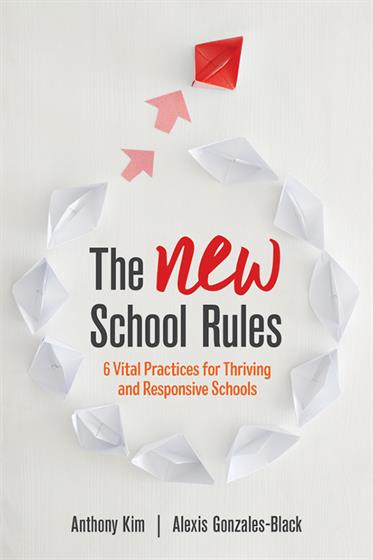Hands-on, Practical Guidance for Educators
From math,
literacy, equity, multilingual learners, and SEL, to assessment, school counseling,
and education leadership, our books are research-based and authored by experts
on topics most relevant to what educators are facing today.

The NEW School Rules
Designed for continuous innovation, this resource expands cutting-edge management and organizational techniques to empower schools with the agility and responsiveness vital in the business world.
- Grade Level: PreK-12
- ISBN: 9781506352763
- Published By: Corwin
- Year: 2018
- Page Count: 216
- Publication date: January 16, 2018
Review Copies
Review copies may be requested by individuals planning to purchase 10 or more copies for a team or considering a book for adoption in a higher ed course. Request review copy - opens in a new tab - opens in a new tab
Description
Actions to increase effectiveness of schools in a rapidly changing world
To stay relevant and impactful, organizations from the military to government agencies to businesses must constantly evolve. Organizations that cling to rigid structures designed for less dynamic times are stuck in routines that don’t get results. Instead of withstanding a structure built for the industrial age, how can we empower our schools to be nimble and equipped to prepare their students for this new world?
The NEW School Rules expands cutting-edge organizational and management strategies into an operating system for responsive schools. These principles and practices provide the framework for transitioning rigid, slow-moving institutions into environments of continuous innovation.
- 6 simple rules create a unified vision of responsiveness among educators
- Real life case studies illustrate responsive techniques implemented in a variety of educational demographics
- 15 experiments guide school and district leaders toward increased responsiveness in their faculty and staff
Author(s)

Anthony Kim
Anthony Kim is a nationally recognized leader in education technology, school design, and personalized learning. As founder and CEO of Education Elements, he has been involved in helping hundreds of schools change the way they think about teaching and learning. As the author of “The Personalized Learning Playbook, Why the Time Is Now”, Anthony has influenced many educators. He has contributed to many publications on new school models including “Lessons Learned from Blended Programs: Experiences and Recommendations from the Field”. Anthony is a nationally recognized speaker on personalized learning and his work has been referenced by the Christensen Institute, iNACOL, EdSurge, CompetencyWorks, EdWeek, District Administrator, and numerous other research reports.
Anthony also founded Provost Systems, which provided online learning solutions to school districts. Provost Systems was acquired by EdisonLearning, where he served as Executive Vice President of Online. Anthony is passionate helping school district can become more nimble, understanding what motivates adult learners, and designing schools that plan for the needs of our future.
Outside of education, Anthony is passionate about triathlons and learning about people who overcome remarkable challenges. He is a San Francisco native and continues to live there with his wife Angela and rescued dogs.

Alexis Gonzales-Black
Alexis Gonzales Black is an expert in organizational design and change initiatives with deep experience in the education, retail, and technology sectors. A Principal Designer at the global design firm IDEO, she designs and implements new organizational models to fuel innovation, agility, and engagement.
Alexis earned a B.S in biology from James Madison University, and developed a passion for teaching and social justice as a high school science teacher and recruiter for Teach For America. At Zappos.com, Alexis led college recruiting and diversity initiatives while co-leading the online retailer's transition to the Holacracy model of organizational design. She founded Thoughtful Org Partners, a consultancy where she partners with organizations to break through?rigidity and introduce self-organizing principles.
Alexis’s work has been widely covered in such media outlets as Forbes, Huffington Post, Fox, and CNN Money. She?is a board member of Responsive Org and formerly an elected member of the Nevada State Board of Education and the West Ed Board of Directors. She lives in the Bay Area with her family.
Table of Contents
Preface
Acknowledgments
About the Authors
Introduction: Why We Need New Organizational Practices for Thriving Schools and Students Today
The Promise of Responsiveness
How Responsive Organizational Thinking Evolved
How This Book Is Designed
A Note About Who This Book Is For
CHAPTER 1. PLANNING: Plan for Change, Not Perfection
When Plans Are More Important Than Our Purpose
Planning Without Learning
Control Is Confused With Planning
Build Roadmaps, Not Manuals
Use Cadences and Pivot Points, Not Just Schedules and Deadlines
Encourage Testing, Experiments, and Responsiveness
EXPERIMENT 1. Define a Clear Purpose
EXPERIMENT 2. Delineate Between What You Know and What You Anticipate
CHAPTER 2. TEAMING: Build Trust and Allow Authority to Spread
We’re Dragged Down by the Slow and Unwieldy Legacy of Hierarchies
Land Grabs Are Still Too Common
When Everyone and No One Is Responsible
Clarify the Purpose of Every Team . . . and Revisit It
Build Trust and Address Tensions
Develop Effective Team Habits That Support Distributed Authority
Embrace Dynamic Team Structures That Evolve and End
EXPERIMENT 3. Offer Feedback as Data
EXPERIMENT 4. Team Meeting Protocol
CHAPTER 3. MANAGING ROLES: Define the Work Before You Define the People
Job Descriptions Get in the Way
Role Overwhelm (and Underwhelm)
Put a Role’s Purpose Before Politics
Separate Roles for Personal Clarity and Smarter Decisions
Value Each Voice as a Human Sensor
EXPERIMENT 5. Role Mapping
EXPERIMENT 6. The One-Question Technique
EXPERIMENT 7. Guidelines for Being an Effective Sensor
CHAPTER 4. DECISION MAKING: Aim for “Safe Enough to Try” Instead of Consensus
The Cycle of Meeting Paralysis
The Risks of Delayed Decision Making
The False Promise of Consensus . . . or Defaulting to a Decider-in-Chief
Get Aligned and Clear Out the Noise
Decide on Things You Can Decide On: Make Decisions Smaller
Fail Forward: Approach Planning and Big Decisions as Decision Cycles
EXPERIMENT 8. Three Language Shifts for Decision-Making Discussions
EXPERIMENT 9. Protocol for a Starting Proposal
EXPERIMENT 10. Default to Yes and Defend No—One Decision at a Time
CHAPTER 5. SHARING INFORMATION: Harness the Flow and Let Information Go
A False Sense of Transparency
Information Has an Expiration Date
Accept Ambiguity
Think of Others: Apply the Reverse Precautionary Principle
Ask for What You Need: Apply the Lesson of Self-Advocacy
Plan Communication as a Process, Not an Event
EXPERIMENT 11. Say “Thank You” for Asking
EXPERIMENT 12. The 3 × 3 Rule
CHAPTER 6. THE LEARNING ORGANIZATION: Schools Grow When People Grow
“Best Practices” Are Inhibiting Learning and Innovation
There Isn’t Learning Without Listening
The Mindset of Efficiency
Use the Physical Environment to Build a Learning Environment
Promote Optimal Zones of Learning (for Adults as Well, Not Just Kids)
Develop a Learning Mindset: The Stance of Agent, Not Subject
Face the Truth
EXPERIMENT 13. Start a Reflection Practice
EXPERIMENT 14. Create a Habit of Learning Every Day
EXPERIMENT 15. Personal Portfolios
A Responsive Roadmap: Beginning the Shift to New Organizational Practices
Three Dimensions of Change
A Plan for Implementation
Frequently Asked Questions and Answers
List of New Rules and Lessons
List of Experiments
References
Index
Reviews
A principal can pick this book up and find excellent advice to help her lead a school without micro-managing.
Melissa Wood-Glusac, English Teacher Grades 9 and 11A principal can pick this book up and find excellent advice to help her lead a school without micro-managing.
Thousand Oaks High School, Thousand Oaks, CA
The NEW School Rules is inspirational, easy to read, and realistic. It offers specific, doable steps to help you get started with implementation and make strides toward becoming part of a responsive organization. Ideal for an administrative team book study.
Kathy Rhodes, PrincipalThe NEW School Rules is inspirational, easy to read, and realistic. It offers specific, doable steps to help you get started with implementation and make strides toward becoming part of a responsive organization. Ideal for an administrative team book study.
Hinton Elementary, Hinton IA
The NEW School Rules tackles organizational change in an interesting and accessible way with adaptable tools and protocols you’ll want to implement in your schools. The desired outcomes are clearly defined through an empathetic design approach.
Jill Gildea, SuperintendentThe NEW School Rules tackles organizational change in an interesting and accessible way with adaptable tools and protocols you’ll want to implement in your schools. The desired outcomes are clearly defined through an empathetic design approach.
Greenwich Public Schools, Greenwich, CT
Discussions about improving education inevitably gravitate to things—curriculum, standards, assessments, technology, professional learning. In The NEW School Rules, Anthony Kim and Alexis Gonzales-Black make a highly compelling case that to fundamentally improve education we must focus on process—specifically, the organizational management, structure, and practice that governs how decisions are made. The authors provide school administrators with an accessible how-to guide for implementing the kinds of organizational changes that will lead to real improvements in student outcomes.
JD Solomon, Editorial DirectorDiscussions about improving education inevitably gravitate to things—curriculum, standards, assessments, technology, professional learning. In The NEW School Rules, Anthony Kim and Alexis Gonzales-Black make a highly compelling case that to fundamentally improve education we must focus on process—specifically, the organizational management, structure, and practice that governs how decisions are made. The authors provide school administrators with an accessible how-to guide for implementing the kinds of organizational changes that will lead to real improvements in student outcomes.
District Administration Magazine
When we take something as beautiful and life-giving as education, and find that managing the institutions that provide it is soul-crushing, we know something is very wrong. The NEW School Rules shows us the problem, offers an alternative vision of educational administration, and gives us the practical tools to unlock new energy in ourselves and our colleagues. Every administrator should read this book.
Matthew Kramer, CEOWhen we take something as beautiful and life-giving as education, and find that managing the institutions that provide it is soul-crushing, we know something is very wrong. The NEW School Rules shows us the problem, offers an alternative vision of educational administration, and gives us the practical tools to unlock new energy in ourselves and our colleagues. Every administrator should read this book.
Wildflower Foundation
The NEW School Rules offers a critical and timely framework to ensure that future generations are equipped to thrive in a rapidly-changing world.
Tony Hsieh, CEO, AuthorThe NEW School Rules offers a critical and timely framework to ensure that future generations are equipped to thrive in a rapidly-changing world.
Zappos, Author of Delivering Happiness
Super practical rules for school change with stated problems, lessons, and experiments you can try tomorrow. The NEW School Rules provides guidance on defining the work, encouraging experimentation, sharing leadership, accepting ambiguity, and turning schools into learning organizations. It is a must-read for leaders of teachers, schools, and systems.
Tom Vander Ark, AuthorSuper practical rules for school change with stated problems, lessons, and experiments you can try tomorrow. The NEW School Rules provides guidance on defining the work, encouraging experimentation, sharing leadership, accepting ambiguity, and turning schools into learning organizations. It is a must-read for leaders of teachers, schools, and systems.
Getting Smart: How Digital Learning is Changing the World
Every school district should read and digest The NEW School Rules. In it, Anthony Kim and Alexis Gonzales-Black make a major contribution to how schools should create teams, organize, and plan to profoundly and positively impact students, teachers, and the community.Michael Horn, Co-Author
Disrupting Class: How Disruptive Innovation Will Change the Way the World Learns
The NEW School Rules is a concrete, battle-tested roadmap for leaders who want to do right by kids by having the courage to help adults embrace change. As a superintendent of ten years (in Newark and New York), I led bold teams that were relentlessly focused on turning around systems that had been failing kids for decades. The central thesis of The NEW School Rules – that districts and schools must fundamentally rethink how they are organized in order to become more responsive, agile, innovative and, ultimately, effective – is spot on. What I appreciate most is that the book is both visionary and evocative – and also practical and instructive. We must build education institutions that put kids’ needs in an ever-evolving world ahead of everything else.
Cami Anderson, Former SuperintendentThe NEW School Rules is a concrete, battle-tested roadmap for leaders who want to do right by kids by having the courage to help adults embrace change. As a superintendent of ten years (in Newark and New York), I led bold teams that were relentlessly focused on turning around systems that had been failing kids for decades. The central thesis of The NEW School Rules – that districts and schools must fundamentally rethink how they are organized in order to become more responsive, agile, innovative and, ultimately, effective – is spot on. What I appreciate most is that the book is both visionary and evocative – and also practical and instructive. We must build education institutions that put kids’ needs in an ever-evolving world ahead of everything else.
Newark Public Schools
The NEW School Rules asks the right questions and poses the right experiments to shift districts and schools to an increased focus on student learning. Kim and Gonzales-Black combine smart practices for running a great organization with the realities faced in many of America’s schools. Preparing every student to succeed in the 21st Century requires that educators work collaboratively to increase the quality of education.
Tim Parker, PresidentThe NEW School Rules asks the right questions and poses the right experiments to shift districts and schools to an increased focus on student learning. Kim and Gonzales-Black combine smart practices for running a great organization with the realities faced in many of America’s schools. Preparing every student to succeed in the 21st Century requires that educators work collaboratively to increase the quality of education.
NEA-Alaska
The NEW School Rules recognizes that adults in the educational system have to learn, evolve, and grow if students are to succeed in an ever-changing world. I wish I’d had this book years ago!
Dale Erquiaga, President/CEOThe NEW School Rules recognizes that adults in the educational system have to learn, evolve, and grow if students are to succeed in an ever-changing world. I wish I’d had this book years ago!
Communities in Schools
Review Copies
Review copies may be requested by individuals planning to purchase 10 or more copies for a team or considering a book for adoption in a higher ed course. Request review copy - opens in a new tab - opens in a new tab
Related Resources
Join us for the Visible Learning
Conference in Las Vegas!
Experience groundbreaking research, inspiring speakers,
and transformative networking. Register Now - opens in a new tab.

